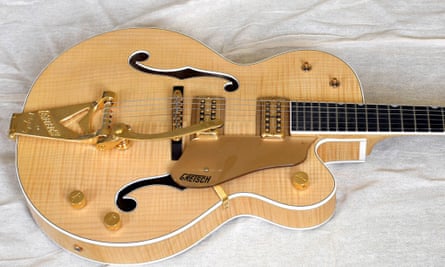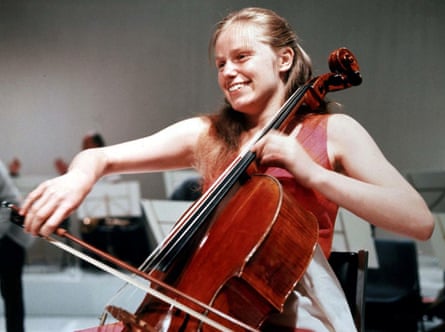A tiny female figure stands in huge, cavernous church in winter, the neck of her electric guitar pointing to the ceiling. Behind her, silently poised, is an ensemble of string players and a choir. The lights are low, and flickering slightly, her shadow is cast into a vast, ghostly giant on a far wall. A packed audience holds its breath. She inhales, opens her lips, and the first vowel, rich and voluminous, emanates, growing, filling the space, building to the end of line at the end of which her larynx climbs to full throttle. The volume and power seems astonishing, and the first long, held note begins to ripple. It has an expressiveness that sends shivers up spines. Then with the first full flourish of arm, her hand strokes the strings in a circular movement as if skimming across a harp, and a rich twang vibrates with a warmth of resonant sustain.
Anna Calvi, an artist I saw perform only last week, is an unusual hybrid. A classically trained violinist, she is not only a surprisingly powerful singer and very gifted guitarist – rarely do the two come together – but also combines effects in voice and playing that capture particular expressivity in vibrato and tremelo. Adopting a dramatic persona and flamenco-style look (behind which is a tiny, meek speaking voice) and using a jangly-sounding Vox AC30 amp, tremelo effects and a Fender Telecaster, Calvi exemplifies qualities variously found in many artists and songs across numerous genres, all of which fall under this topic – oscillation in its many glorious forms.
So this week it is all about sounds that move, as opposed to those played with straight, unbending or unaltered notes or chords. We may feature high-pitched warbles, medium wobbles and or deep bass shudders – from vocal delivery or instruments from rumbling, rattling, organ sounds to guitar techniques or effects. But the important thing is that the oscillation must work well and feature prominently in that song.

Let’s look at the detail. Vibrato is defined as subtle variations of pitch (to slightly higher or lower frequency notes), or can also be the speed of that variation. This is often confused with tremelo, which strictly speaking is subtle changes of volume, not pitch. Tremelo arms on guitars from the old Kauffman Vibrola on models such as a 1930s Rickenbacher, to the popular Bigsby tremelo, seen on Gretsch guitars or other makes, actually change the pitch of the strings, so they are actually creating a from of vibrato.
Guitarists also produce changes in sound by bending strings, moving a slide bottleneck, or using a wah-wah pedal, or other effects to change frequency and volume. Funk players or surf style are a good example. The many artists could inclue Jimi Hendrix, JImmy Page, Prince, Steve Miller, the tremelo bends of Duane Eddy, Keith Richards, or Dan Auerbach from the Black Keys. It could include the blurry, dreamy innovation of Kevin Shields from My Bloody Valentine. They all count. The key element is that songs must modulate their notes or chords with effectiveness, innovation and expression.

A tremolo or tremolando can also be the rapid repetition of the same note, most clearly shown by a roll on the drums. On other instruments this can sound like modulation and is easily recreated on synthesisers and software. A trill, meanwhile, is the rapid alternation between two very close notes. That is also in the frame this week, because of the modulatory effect in a song or other musical piece. String players often play trills, but as they mature they naturally discover and achieve even more expression by wobbling their finger when pressing down on strings. A music teacher at school once told me how he noticed children naturally adopting the wobble finger technique on violins and cellos and upright basses, almost always as if like clockwork, half way through the fourth year of lessons. The cellist Jacqueline du Pré, who died tragically young, was a player whose finger vibrato was incredibly moving.

Organs and synthesisers perhaps present the best examples of manufactured oscillation. The Hammond and Moog are the most famous examples, built to modulate pitch to create that rich, shuddery sound. A rich vein of organ music traversed into pop in the 60s and 70s. Organs may also come up in a future topic, but in this one, it’s all about the oscillation. In church organs, a similar effect is created by creating mechanical changes in airflow, and players of wind instruments can achieve a similar result by controlling it with their diaphragm. In the case of brass instruments, this is also done by subtle movements with the lips or moving the instrument with the hand.
What of vibrato in the voice? Singers change learn to modify pitch or volume, or both. Sometimes it is entirely natural, and they cannot control it, but when it works well, it can have a profound effect. When I first heard opera singers as a child I thought the stylistic warble slightly laughable. You could argue that big stars such as Beyoncé, Maria Carey or Whitney Houston put on a forced vibrato, but is this brilliantly skilful or over-stylised? But in the soul genre or others, when is vibrato used well, and in what songs? Now is the time to name examples and discuss in comments.

Vocal vibrato is especially interesting, because it is often untrained. Some singers are naturally stylish this way, their sound a bit like the delivery of a cricketer who naturally finds swing or spin, or a footballer who bends a free kick or an actor or comedian whose voice somehow delivers a line that sparkles and sings. I’ve dabbled in all of these activities. But my own equivalent is of a tendency to sound gently mocking or ironic even when speaking with entire sincerity. It just comes out that way. I’m not sure it’s a talent, as such. There seems to be something in my tone of voice that can bring a lot of fun for those who get it, or alternatively causes misunderstanding and trouble.
Vibrato can also arguably break down the artificial ridges of formal notes (or frequency) divisions imposed by western music, and allow more freedom to roam in the intricate variations in between found in Chinese, Arabic or other forms. The unusual harmonies and half-notes of Bulgarian female choirs are an example of these divisions bridging different cultures.
But why do pitch changes, subtle or otherwise, catch our attention and move us? Perhaps it is because there is a physical element to it. So let’s watch how this happens when expressed by grains of sand. There are complex scientific reasons, but to me it’s shapeshifting magic.
And in some ways, even more amazing, let’s now watch the effect that sine waves can have on flowing water. Does it flow up, or is it just an illusion?
Does that alter and move you? What is your wavelength? Not sure what is a vibrato and what isn’t? In lyrics, your song choices also reflect rapid changes in emotions or other forms of oscillation. While the topic is mostly about sound, flitting and flickering in a bigger sense may also be worth a shout, where form matches subject matter.
Overall this is a big subject that should travel across many in genres and cultures, but it’s a two-week Christmas special with extra time to build a musical mountain and a vast, flowing river of songs. Therefore dig deep in your metaphorical Christmas sacks and present an oscillating array of riches to the returning yuletide guest guru, magicman, in comments and optionally in the Spotify playlist by lunchtime last orders (2pm) Monday 29 December for his special selection published on Thursday 1 January 2015.
Finally, thank you all once again for another outstanding 12 months of wit, wisdom, knowledge and friendship. Readers Recommend truly rocks. Have a very merry Christmas and a happy New Year.
To increase the likelihood of your nomination being considered, please:

Comments (…)
Sign in or create your Guardian account to join the discussion